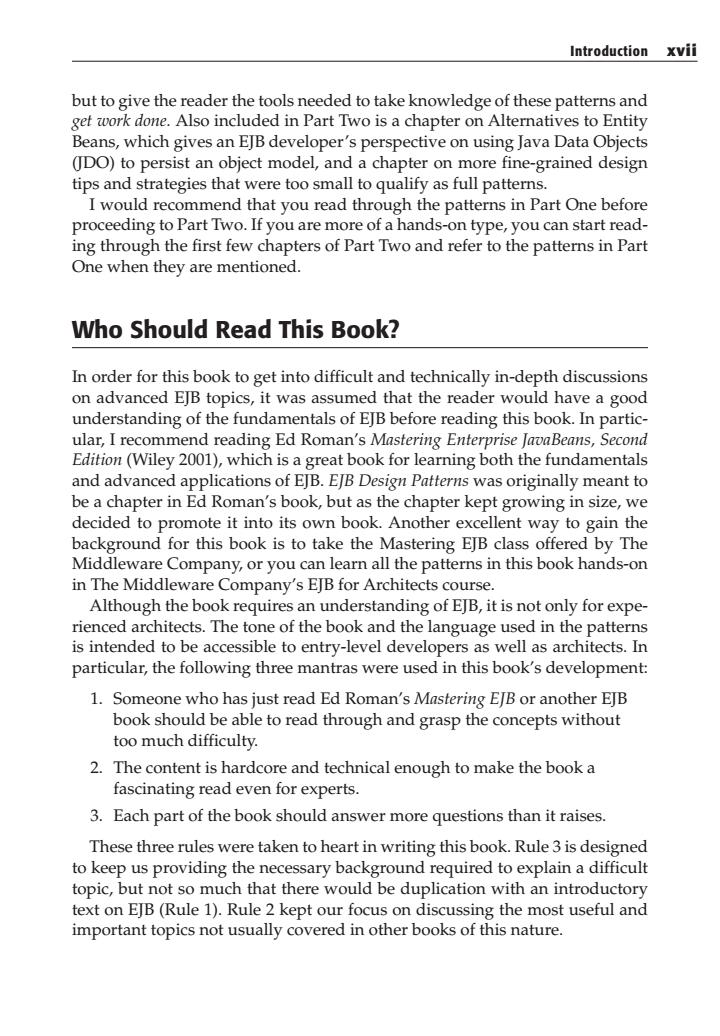正在加载图片...

Introduction xvii but to give the reader the tools needed to take knowledge of these patterns and get work done.Also included in Part Two is a chapter on Alternatives to Entity Beans,which gives an EJB developer's perspective on using Java Data Objects (DO)to persist an object model,and a chapter on more fine-grained design tips and strategies that were too small to qualify as full patterns. I would recommend that you read through the patterns in Part One before proceeding to Part Two.If you are more of a hands-on type,you can start read- ing through the first few chapters of Part Two and refer to the patterns in Part One when they are mentioned. Who Should Read This Book? In order for this book to get into difficult and technically in-depth discussions on advanced EJB topics,it was assumed that the reader would have a good understanding of the fundamentals of EJB before reading this book.In partic ular,I recommend reading Ed Roman's Mastering Enterprise JavaBeans,Second Edition (Wiley 2001),which is a great book for learning both the fundamentals and advanced applications of EJB.EJB Design Patterns was originally meant to be a chapter in Ed Roman's book,but as the chapter kept growing in size,we decided to promote it into its own book.Another excellent way to gain the background for this book is to take the Mastering EJB class offered by The Middleware Company,or you can learn all the patterns in this book hands-on in The Middleware Company's EJB for Architects course. Although the book requires an understanding of EJB,it is not only for expe rienced architects.The tone of the book and the language used in the patterns is intended to be accessible to entry-level developers as well as architects.In particular,the following three mantras were used in this book's development: 1.Someone who has just read Ed Roman's Mastering EJB or another EJB book should be able to read through and grasp the concepts without too much difficulty. 2.The content is hardcore and technical enough to make the book a fascinating read even for experts. 3.Each part of the book should answer more questions than it raises. These three rules were taken to heart in writing this book.Rule 3 is designed to keep us providing the necessary background required to explain a difficult topic,but not so much that there would be duplication with an introductory text on EJB(Rule 1).Rule 2 kept our focus on discussing the most useful and important topics not usually covered in other books of this nature. but to give the reader the tools needed to take knowledge of these patterns and get work done. Also included in Part Two is a chapter on Alternatives to Entity Beans, which gives an EJB developer’s perspective on using Java Data Objects (JDO) to persist an object model, and a chapter on more fine-grained design tips and strategies that were too small to qualify as full patterns. I would recommend that you read through the patterns in Part One before proceeding to Part Two. If you are more of a hands-on type, you can start reading through the first few chapters of Part Two and refer to the patterns in Part One when they are mentioned. Who Should Read This Book? In order for this book to get into difficult and technically in-depth discussions on advanced EJB topics, it was assumed that the reader would have a good understanding of the fundamentals of EJB before reading this book. In particular, I recommend reading Ed Roman’s Mastering Enterprise JavaBeans, Second Edition (Wiley 2001), which is a great book for learning both the fundamentals and advanced applications of EJB. EJB Design Patterns was originally meant to be a chapter in Ed Roman’s book, but as the chapter kept growing in size, we decided to promote it into its own book. Another excellent way to gain the background for this book is to take the Mastering EJB class offered by The Middleware Company, or you can learn all the patterns in this book hands-on in The Middleware Company’s EJB for Architects course. Although the book requires an understanding of EJB, it is not only for experienced architects. The tone of the book and the language used in the patterns is intended to be accessible to entry-level developers as well as architects. In particular, the following three mantras were used in this book’s development: 1. Someone who has just read Ed Roman’s Mastering EJB or another EJB book should be able to read through and grasp the concepts without too much difficulty. 2. The content is hardcore and technical enough to make the book a fascinating read even for experts. 3. Each part of the book should answer more questions than it raises. These three rules were taken to heart in writing this book. Rule 3 is designed to keep us providing the necessary background required to explain a difficult topic, but not so much that there would be duplication with an introductory text on EJB (Rule 1). Rule 2 kept our focus on discussing the most useful and important topics not usually covered in other books of this nature. Introduction xvii